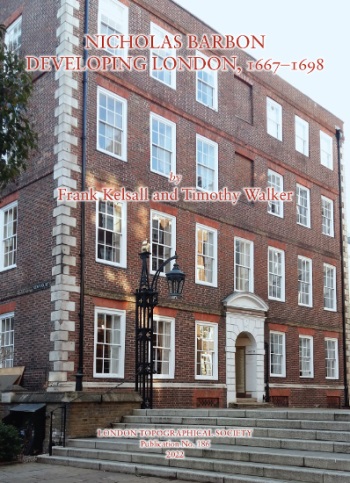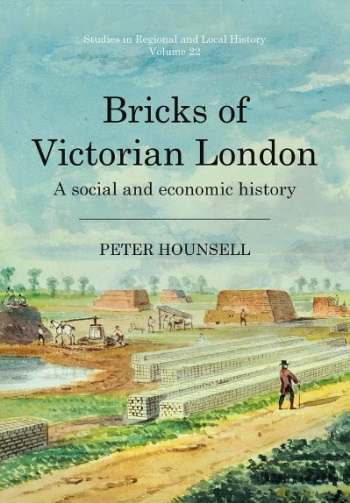London brick by brick

|

|
| Nicholas Barbon: Developing London, 1667–1698, Frank Kelsall and Timothy Walker, London Topographical Society, Publication No 186, 2022, 230 pages, 111 colour and black-and-white illustrations. | Bricks of Victorian London: a social and economic history, Peter Hounsell, University of Hertfordshire Press, Studies in Regional and Local History, Volume 22, 2022, 283 pages, extensive colour and black-and-white illustrations, hardback. |
The current political debate about the over-dominance of London in the life of the nation and concerns about its growth into the surrounding countryside have a long history. Although it is now labelled with the slick slogan of ‘levelling up’, its origins can be traced as far back as the failed attempts to control new building in the city and its immediate environs in the late 16th and throughout the first half of the 17th centuries. The Plague of 1665, which decimated the population of London, closely followed by the Great Fire of the following year, which destroyed much of its fabric, provided an opportunity for aggressive developers to transform the city to their own personal advantage.
The leading developer was Nicholas Barbon, an extraordinary character. This deeply researched book is the first full biography to explore his complicated career, and to place it within a contemporary political and economic context. It is to Barbon that we owe the development of the brick terraces and squares which characterise London from the late 17th century onwards. He was the son of a radical Puritan preacher who was imprisoned for treason in the Tower in 1661. Nicholas was educated at Oxford before studying medicine and taking a doctorate in the Netherlands. His brief medical career included remaining in London during the Plague, when he offered his services for free, but it was in the aftermath of the fire that his controversial career as a developer took off.
Starting with some small developments to replace buildings that had been destroyed, he soon graduated to the wholesale redevelopment of redundant aristocratic houses, a number of green and brownfield sites, and various developments for the Inns of Court. He suffered from a lack of capital throughout his life, but his ingenious methods of financing his developments and the resulting litigation are explained at length by the authors. Although not alone, he was by far the most active developer in London until his death in 1698. By then he was the owner of a grand country mansion at Osterley, had established one of the first fire insurance companies and a national bank to enhance the value of his developments, published numerous pamphlets on economic and political themes, and become an MP to gain social status and to protect himself from action in the courts. He provoked bitter controversy in his own lifetime, which has resonated with later commentators.
All of this is explored at length and given a thorough context in this long-awaited publication, which presents a balanced portrait of a difficult man and the world in which he operated. He was neither an architect nor a hands-on builder. Only a very few of his buildings have survived unaltered but his impact remains visible in the fabric of the city today. As the authors rightly conclude, ‘Barbon’s methods set the model for the future of London’s building, dominated by private developers using land as it became available for uniform terraces’.
Bricks and brickmaking were central to Barbon’s developments, so it is timely that this richly-documented study coincides with the publication of another book which takes the growth of London forward over the following two centuries. Brickmaking was a seasonal activity which for much of the period was conducted by small teams working in brickfields scattered around the countryside on the edges of London and the home counties. Hounsell’s book explores the diverse variety of the people involved, from the landowners with suitable clay, through the entrepreneurs who exploited it to the brickies who produced the finished product. Set within a broad economic framework which examines supply and demand, costs and transportation, it is an exhaustive study which is fully documented and illuminated by helpful illustrations.
Of particular interest are the chapters devoted to the harsh life endured by the seasonal workers, which explains the processes involved in making bricks by hand before the increasing adoption of mechanisation towards the end of the century. The contribution of women and children is fully acknowledged, and there are evocative chapters on the living arrangements of the brickmakers, and the role of drink and religion in their working and domestic lives. By the second half of the century, they gradually began to organise themselves in trade unions to press for improved conditions and better wages, which inevitably led to a number of industrial disputes.
The book concludes with the drastic decline of the local brickfields as production shifted to the highly mechanised industry in the Midlands, making cheaper Fletton bricks, and as the demand for ever more housing on the outskirts of London made their rural locations more valuable for development.
Both books under review are serious academic studies with extensive lengthy quotations from the original documentary sources. Together they provide a coherent account that illuminates the development and appearance of London over four centuries. The introduction to the monograph on Barbon ends with a thought-provoking passage that is worth quoting in full: ‘The issues that Barbon was concerned with at the end of the 17th century seem eerily familiar to the present day. Is London too large, does it take too much of the country’s wealth, should it allow so much redevelopment, why is it so different from the rest of the country?’
The authors do not offer any easy answers to these questions, but in stimulating thoughtful debate, both of these books can be seen to have a contemporary relevance. Beautifully produced and illustrated, they provide a scholarly basis for a better understanding of the evolution of London and its suburbs.
This article originally appeared in the Institute of Historic Building Conservation’s (IHBC’s) Context 176, published in June 2023. It was written by Malcolm Airs, emeritus fellow, Kellogg College Oxford.
--Institute of Historic Building Conservation
Related articles on Designing Buildings
- After the Fire: London churches in the age of Wren, Hooke, Hawksmoor and Gibbs.
- Brick.
- Conservation area.
- Conservation.
- Heritage.
- Historic environment.
- IHBC articles.
- Institute of Historic Building Conservation.
- London Bridge and its houses, c1209-1761.
- Mortar.
- Pointing.
- Practical Building Conservation: Earth, Brick and Terracotta.
- The influence of geology on English brickmaking.
- The Livery Halls of the City of London.
- Types of bricks.
IHBC NewsBlog
Old Sarum fire in listed (& disputed) WW1 Hangar - Wiltshire Council has sought legal advice after fire engulfed a listed First World War hangar that was embroiled in a lengthy planning dispute.
UK Antarctic Heritage Trust launches ‘Virtual Visit’ website area
The Trust calls on people to 'Immerse yourself in our heritage – Making Antarctica Accessible'
Southend Council pledge to force Kursaal owners to maintain building
The Council has pledged to use ‘every tool in the toolbox’ if urgent repairs are not carried out.
HE’s Research Magazine publishes a major study of the heritage of England’s suburbs
The article traces the long evolution of an internal programme to research 200 years of suburban growth
IHBC Context 183 Wellbeing and Heritage published
The issue explores issues at the intersection of heritage and wellbeing.
SAVE celebrates 50 years of campaigning 1975-2025
SAVE Britain’s Heritage has announced events across the country to celebrate bringing new life to remarkable buildings.
IHBC Annual School 2025 - Shrewsbury 12-14 June
Themed Heritage in Context – Value: Plan: Change, join in-person or online.
200th Anniversary Celebration of the Modern Railway Planned
The Stockton & Darlington Railway opened on September 27, 1825.
Competence Framework Launched for Sustainability in the Built Environment
The Construction Industry Council (CIC) and the Edge have jointly published the framework.
Historic England Launches Wellbeing Strategy for Heritage
Whether through visiting, volunteering, learning or creative practice, engaging with heritage can strengthen confidence, resilience, hope and social connections.














